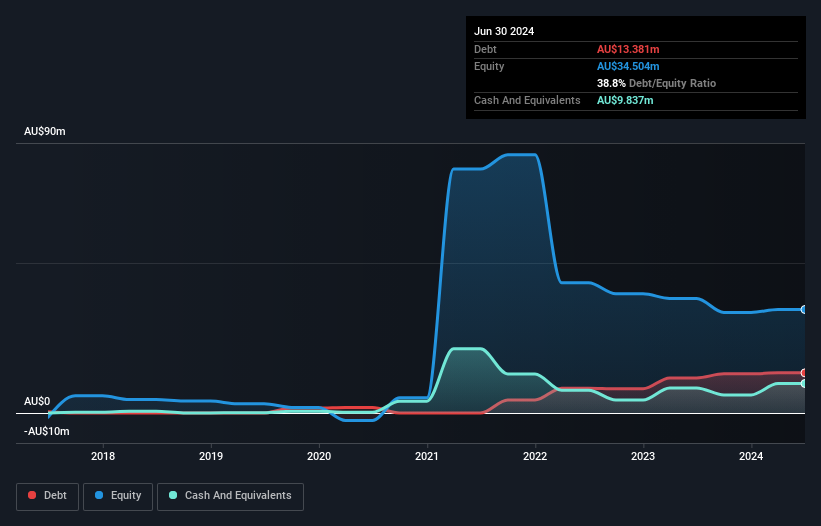Some say volatility, rather than debt, is the best way to think about risk as an investor, but Warren Buffett famously said that 'Volatility is far from synonymous with risk.' When we think about how risky a company is, we always like to look at its use of debt, since debt overload can lead to ruin. We note that Spenda Limited (ASX:SPX) does have debt on its balance sheet. But should shareholders be worried about its use of debt?
What Risk Does Debt Bring?
Debt and other liabilities become risky for a business when it cannot easily fulfill those obligations, either with free cash flow or by raising capital at an attractive price. Ultimately, if the company can't fulfill its legal obligations to repay debt, shareholders could walk away with nothing. However, a more usual (but still expensive) situation is where a company must dilute shareholders at a cheap share price simply to get debt under control. Of course, the upside of debt is that it often represents cheap capital, especially when it replaces dilution in a company with the ability to reinvest at high rates of return. The first step when considering a company's debt levels is to consider its cash and debt together.
See our latest analysis for Spenda
What Is Spenda's Debt?
You can click the graphic below for the historical numbers, but it shows that as of June 2024 Spenda had AU$13.4m of debt, an increase on AU$11.7m, over one year. However, because it has a cash reserve of AU$9.84m, its net debt is less, at about AU$3.54m.

A Look At Spenda's Liabilities
The latest balance sheet data shows that Spenda had liabilities of AU$2.53m due within a year, and liabilities of AU$14.0m falling due after that. Offsetting these obligations, it had cash of AU$9.84m as well as receivables valued at AU$11.0m due within 12 months. So it actually has AU$4.32m more liquid assets than total liabilities.
This surplus suggests that Spenda has a conservative balance sheet, and could probably eliminate its debt without much difficulty. The balance sheet is clearly the area to focus on when you are analysing debt. But it is Spenda's earnings that will influence how the balance sheet holds up in the future. So when considering debt, it's definitely worth looking at the earnings trend. Click here for an interactive snapshot.
In the last year Spenda wasn't profitable at an EBIT level, but managed to grow its revenue by 73%, to AU$5.4m. With any luck the company will be able to grow its way to profitability.
Caveat Emptor
While we can certainly appreciate Spenda's revenue growth, its earnings before interest and tax (EBIT) loss is not ideal. Its EBIT loss was a whopping AU$11m. Looking on the brighter side, the business has adequate liquid assets, which give it time to grow and develop before its debt becomes a near-term issue. Still, we'd be more encouraged to study the business in depth if it already had some free cash flow. So it seems too risky for our taste. The balance sheet is clearly the area to focus on when you are analysing debt. However, not all investment risk resides within the balance sheet - far from it. For example Spenda has 6 warning signs (and 3 which are potentially serious) we think you should know about.
Of course, if you're the type of investor who prefers buying stocks without the burden of debt, then don't hesitate to discover our exclusive list of net cash growth stocks, today.
New: Manage All Your Stock Portfolios in One Place
We've created the ultimate portfolio companion for stock investors, and it's free.
• Connect an unlimited number of Portfolios and see your total in one currency
• Be alerted to new Warning Signs or Risks via email or mobile
• Track the Fair Value of your stocks
Have feedback on this article? Concerned about the content? Get in touch with us directly. Alternatively, email editorial-team (at) simplywallst.com.
This article by Simply Wall St is general in nature. We provide commentary based on historical data and analyst forecasts only using an unbiased methodology and our articles are not intended to be financial advice. It does not constitute a recommendation to buy or sell any stock, and does not take account of your objectives, or your financial situation. We aim to bring you long-term focused analysis driven by fundamental data. Note that our analysis may not factor in the latest price-sensitive company announcements or qualitative material. Simply Wall St has no position in any stocks mentioned.
About ASX:SPX
Spenda
Develops and commercializes technology assets that enable the modernization of business IT systems through conversion, migration, and management of server-based legacy data and systems to the cloud in Australia.
Flawless balance sheet and fair value.
Market Insights
Community Narratives


Recently Updated Narratives

Astor Enerji will surge with a fair value of $140.43 in the next 3 years

Proximus: The State-Backed Backup Plan with 7% Gross Yield and 15% Currency Upside.


A case for for IMPACT Silver Corp (TSXV:IPT) to reach USD $4.52 (CAD $6.16) in 2026 (23 bagger in 1 year) and USD $5.76 (CAD $7.89) by 2030
Popular Narratives


MicroVision will explode future revenue by 380.37% with a vision towards success


The company that turned a verb into a global necessity and basically runs the modern internet, digital ads, smartphones, maps, and AI.



